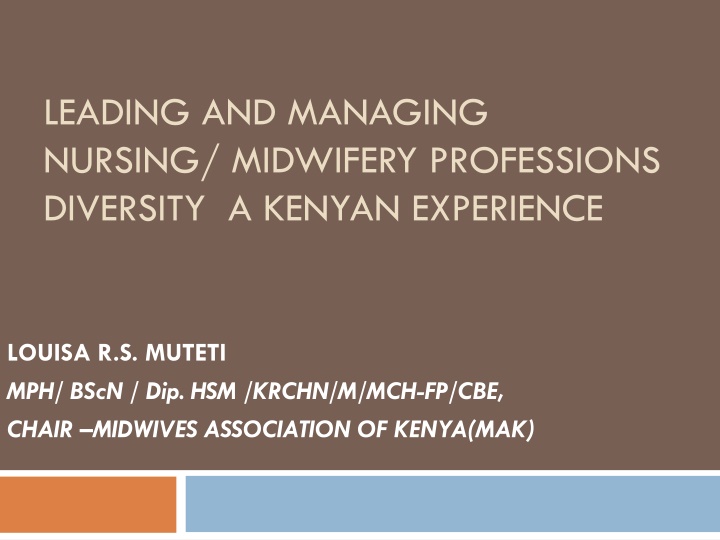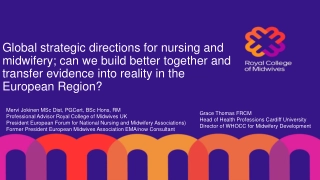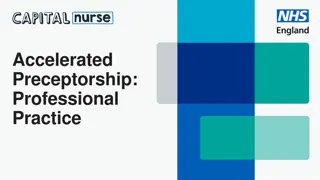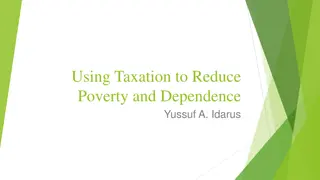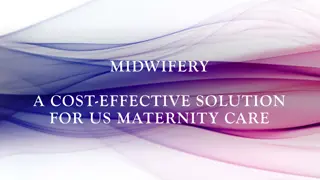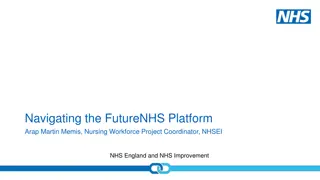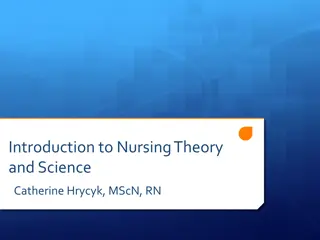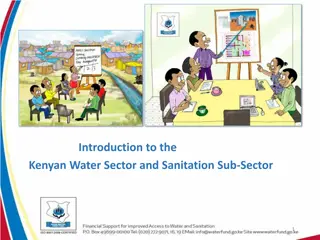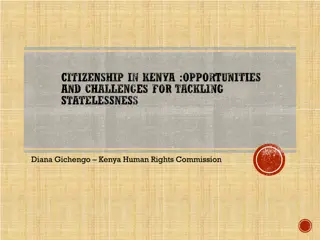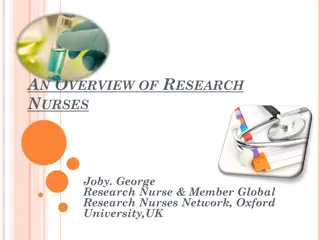Leading and Managing Nursing/Midwifery Professions Diversity: A Kenyan Experience by Louisa R.S. Muteti
Louisa R.S. Muteti discusses the leadership and management diversity in nursing and midwifery professions in Kenya, pre and post-devolution eras. The article explores the distinctions between nursing and midwifery, challenges, opportunities, and drivers of diversity in these professions.
Download Presentation

Please find below an Image/Link to download the presentation.
The content on the website is provided AS IS for your information and personal use only. It may not be sold, licensed, or shared on other websites without obtaining consent from the author.If you encounter any issues during the download, it is possible that the publisher has removed the file from their server.
You are allowed to download the files provided on this website for personal or commercial use, subject to the condition that they are used lawfully. All files are the property of their respective owners.
The content on the website is provided AS IS for your information and personal use only. It may not be sold, licensed, or shared on other websites without obtaining consent from the author.
E N D
Presentation Transcript
LEADING AND MANAGING NURSING/ MIDWIFERY PROFESSIONS DIVERSITY A KENYAN EXPERIENCE LOUISA R.S. MUTETI MPH/ BScN / Dip. HSM /KRCHN/M/MCH-FP/CBE, CHAIR MIDWIVES ASSOCIATION OF KENYA(MAK)
BACKGROUND INFORMATION DEFINITION OF TERMS USED KEY SEARCH WORDS Nursing, midwifery, diversity, leadership and management SIMPLIFYIED DEFINATIONS Leading- influencing people to carry out tasks for achievement of objectives. Managing getting things done as planned through the workforce Diversity Understanding, respect and acceptance concept as relates to individuals in any assignment. Appreciating others peoples difference in knowledge, attitude and practice in doing or dealing with issues. Nursing Alleviating suffering for the sick or well and supporting dignified death in the caring process as a key concept; focus is more on cause of discomfort or ill health/ disease in order to provide relative comfort in the caring process. Midwifery supporting normal physiological processes in the lifecycle including sexual & reproduction as well as child care as a key concept. Disease is not necessarily part of the physiological process but rather an anticipated possible challenge
BACKGROUND INFORMATION-2 Nursing and midwifery are caring professions that are knowledge, attitude and skill intensive; In some countries there exist confusion between the two caring profession; Major hospitals benefit alot when there is clear distinction between nursing & midwifery -sustained KAP for continuous quality improvement in care provision is enhanced; Recognition and appreciation of different knowledge, attitude and skills in different individuals.
DISCUSSION AIM & OBJECTIVES AIM; To discus nursing and midwifery leadership and management diversity in the pre and post devolution eras in Kenya; OBJECTIVES To analyze the Pre and post devolution leadership and management status for nursing and midwifery in Kenya; To discussion observed scenarios on diversity leadership and management with their drivers for nursing and midwifery professions in the pre/post devolution; To discuss the post devolution opportunities and challenges to diversity in leading & managing nursing / midwifery professions in Kenya.
NURSING & MIDWIFERY IN PRE- DEVOLUTION ERA IN KENYA Colonial time in 1950 s a nursing midwives and health visitors Council was established under Kenyan laws- cap. 257 for regulation of education & practice. After independence 1978 Health for All by the year 2000 WHO declaration started to affect the caring professions; Clamour for a comprehensive nurse for PHC was mooted and piloted in Mombasa KMTC for certificate and was quickly followed by a diploma program(KECHN & KRCHN). It was the same template used to replicated for the bachelor degree program a few years later 1988 1990 in Baraton university and University of Nairobi as others followed. Nursing department in MOH had three sections/units that looked at efficiency/ effectiveness in care provision:- (General Nursing, Midwifery and Community Health Nursing/ Public health Nursing).
Pre- devolution cont.1 The three units were tailored as programs for quality care ( general nursing and midwifery for hospitals with Community Health/ public health nursing for rural health/primary health care services). NB. Quality of care for clients and patients was enhanced in each area - ONE head for the whole process ensured each unit head were well prepared through mentorship , coaching and supervision for new recruits at MOH HQRS and major hospitals.
POST DEVOLUTION ERA National government attempted to sustain diversity to counties without much success. County governments wanted autonomy in managing the Human Resources Health as well as the Health system as a whole; Inheritance of nursing and midwifery care process were not uniform in the 47 counties; Not all nursing/midwifery staff deployed in County leadership and management were health system management (HSM) Trained.
POST DEVOLUTION ERA-2 Critical decisions were therefore done with little or no competencies; Many training institutions were set up public, private and faith based; No clear specific preparation for most educators(deployment of lecturers versus learners ratio), Disparity in student preceptor/ mentor ratio set in in many county practical placement sites; Preparation for preceptors/mentors was overtaken by unfolding event; This has further interfered with the leadership/ management diversity to be realized from recruitment and deployment.
OBSERVED SCENARIOS EDUCATION ; Quality to be addressed urgently; lecturer /student ratio, preceptor/ student ratio from many schools with unprepared practical sites, REGULATION; review needed urgently for consumer/ provider protection; There is need to entrench diversity for continuous quality improvement in Nursing and midwifery care. Regulation is for provision of social justice for consumers and providers in order to ensure a safe and secure working environment (Nadya and Ariss -2019).
OBSERVATIONS- 2 PRACTICE- need for diversity to enhance quality through updates, training, mentorship etc; It is important to link knowledge to attitude that produce the required competence as a leader or manager. Hence, leading by example as confidence and competency are essential not only in ensuring safe practice but to provide a safe and secure feeling from led staff (Sheena & Soo-2010).
OBSERVATIONS- 3 ASSOCIATION- to advocate for quality , respect and acceptance for diversity; has an imperative to advocate for quality, understanding, respect and acceptance for diversity as a strategy for growth and development through common diplomatic approach for the caring profession. Midwifery leaders/ managers should specifically lobby for women centered care as well as midwife led model of care as opposed to medical model of care that robs women childbearing process experience (Yanti et al.2015).
OBSERVATIONS- 4 RESEARCH- mostly they are a project or academic related studies. The priority should address the key challenges that hinder unity in diversity for enhanced visibility and empowerment for the largest health care workforce globally not only in Kenya (Robbie E & Davis Floyd- 1998).
POST DEVOLUTION OPPORTUNITIES Diversity in developing competent nurses and midwives for enhanced continuous quality improvement; Lobby for better human resource deployment for improved health outcomes accordingly; Identify institutions for skills refreshment/ enhancement for lecturers/ manager/ leaders ; Ensure diversity in service delivery at all levels.
POST DEVOLUTION CHALLENGES Negative attitude in both leaders/mangers or staff; Leadership/ management theories used by institutions may not encourage diversity; Erroneous perception of diversity for delivery of quality health care by nurses/midwives. Cultural , socio economic status , language used in leading and managing in caring professions.
CHALLENGES -2 Discriminations privileges and disadvantages; Lack of positive, fostering safe environments ; Unclear Policies, standards and guidelines at different levels; Personality traits of individuals involved knowledge, physical abilities, beliefs and other ideologies ; Lack of staff involvement in diversity concept;
BENEFITS OF DIVERSITY AT WORK PLACE Broader market due to variety skills & experiences more capacity for different activities, Increased productivity- expertise mix with experiences with improved team work, Innovation through shared knowledge/ experiences Easier recruitment and retention for staff for specific activities, Increased adaptability to market products according to emerging trends
DISCUSSIONS Organization culture- HR M practices, expectations, incentives perceived impact , tenure, education background, set goals to be achieved; Need to build trust in diverse professional orientations; Deal with emerging issues Globally, Regionally and Nationally-Locally; Grow and develop excellence in the caring professions towards quality enhancement.
DISCUSSION-2 Priscilla dike-(2013) described two dimensions critical is addressing diversity as primary and secondary. In primary age, gender and so forth, which are easily noticeable. The secondary dimension included education, religion, income , origin these are noticed following several interactions. In the process we need collaborative teams who support each other for achieving set goals.
CONCLUSION This way the best available staff for both professions will be used to propel the teams to be recognized, accepted and respected hence visible at all levels. To lead and manage diversity require tolerance, open mindedness, open communication with capacity to manage conflicts that may arise, Respect and acceptance of all as individuals with different talents that can be positively used; As teams develop working policies, standards and guidelines as issues emerge; Monitor and evaluate quality of care objectively for continuous improvement.
RECOMENDATIONS Nursing and Midwifery leaders must possess technical knowledge, social, emotional abilities in order to; Beat and meet the dynamism challenges; Be able to maximize the human capital around them to achieve goals. It is important to note that emotional intelligence has more value than analytical and technical skills combined (Ryan-2013). Because they are approachable, positive, warm, optimistic and empathetic leaders They tend to produce effective results with their teams.
RECOMMENDATIONS-2 To break the disconnect between the academicians/ scholars and service providers in ensuring effective Continuous Quality Improvement (CQI) care in Nursing and Midwifery professions. Organize workplace teams linked to research institutions for continuous evidence gathering and sharing. Ensure areas for centers of excellence in nursing or midwifery. NB: this means that we must produce leaders as well as managers in the two critical professions not just a leader or a manager.
RECOMMENDATIONS-3 To lead and mange nursing and midwifery by example require those who work as hard as everybody else, demonstrate competency as they lead the teams. Beyond task allocation by the manager, the leader as a role to bring out the best in people through emotional capacity display and to facilitate rapport in effective communication, That is why we need to break the disconnect between the academicians/ scholars and service providers in ensuring effective Continuous Quality Improvement (CQI) care in Nursing and Midwifery professions.
END THANKS ASANTE SANA URIO MUNO GALAATOMA MWEGA FULU NUSEO MUNO BERA AINYA NI WEGA MUNO
